
| Palaeos: |  |
Tetrapoda |
| The Vertebrates | Eucritta |
| Page Back | Unit Home | Unit Dendrogram | Unit References | Taxon Index | Page Next |
| Unit Back | Vertebrates Home | Vertebrate Dendrograms | Vertebrate References | Glossary | Unit Next |
|
Abbreviated Dendrogram
SARCOPTERYGII | TETRAPODA |--Acanthostega `--+--Ichthyostega `--+--Crassigyrinus `--+--Colosteidae | `--Greererpeton `--+--Baphetidae | |--Loxomma | `--+--Baphetes | `--Megalocephalus |--Eucritta `--Tetrapoda* |--TEMNOSPONDYLI `--+--LEPOSPONDYLI `--REPTILIOMORPHA |
Contents
Overview |
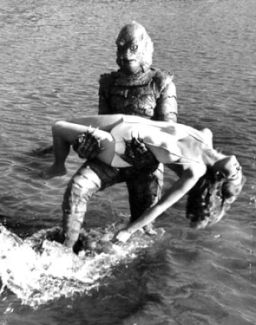 Eucritta melanolimnetes is The Creature from the Black Lagoon. No, not that creature, this creature!
Eucritta melanolimnetes is The Creature from the Black Lagoon. No, not that creature, this creature! 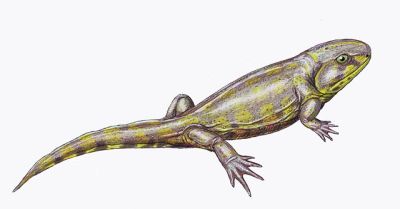 It was a very primitive and modest sized (about 25 centimetres long, not nearly big enough to carry off maidens) amphibian, that is extraordinary for its combination of amphibian and reptilian - or to put it more technically, baphetid, temnospondyli, and anthracosaurian - characteristics. The presence of so many different traits makes its exact placement uncertain. The best we can say is that it is a good representative of the sort of ancestral type from which all other tetrapods (all amphibians and reptiles apart from the primitive ancestral ones described in this unit) might have evolved. MAK111110
It was a very primitive and modest sized (about 25 centimetres long, not nearly big enough to carry off maidens) amphibian, that is extraordinary for its combination of amphibian and reptilian - or to put it more technically, baphetid, temnospondyli, and anthracosaurian - characteristics. The presence of so many different traits makes its exact placement uncertain. The best we can say is that it is a good representative of the sort of ancestral type from which all other tetrapods (all amphibians and reptiles apart from the primitive ancestral ones described in this unit) might have evolved. MAK111110
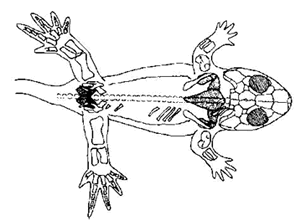 Eucritta:
E. melanolimnetes Clack 1998
Eucritta:
E. melanolimnetes Clack 1998
Range: Early Carboniferous (Brigantian, latest Visťan) of Europe (Britain).
Phylogeny: Tetrapoda ::::: Tetrapoda* + Baphetidae + *.
Characters: $ snout short with nasals square or hexagonal; full
compliment of dermal roofing bones [C98]; orbit anteroventrally embayed (perhaps
only in larger individuals) [C01]; frontals long & narrow, without
participation in orbit [C01]; prefrontal only weakly sutured to lacrimal &
nasals [C01]; $ postorbital broadly crescentic without ventral process
into orbit margin [C98]; $ skull table approximately square [C98];
parietals short, forming hexagonal plate [C01]; pineal foramen just posterior to
orbits [C01]; postparietals relatively long [C01]; intertemporal present [C01]; $
supratemporal broadly crescentic [C98]; supratemporal contacts postparietal
[C98]; supratemporal surrounds most of otic notch (not squamosal) [C98]; $
distance from apex of otic notch to orbit less than diameter of orbit [C98];
tabulars square, without button or horn (C01 notes that horn may have been lost)
[C01]; paraquadrate
foramen present [C01]; quadrate with 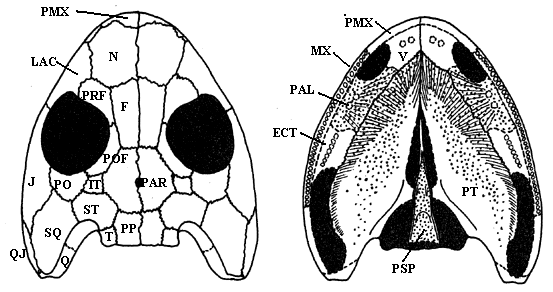 broad
dorsal plate and ventral articular surface [C01]; parasphenoid with broad
triangular body thickened at edges in anterior portion [C98] [C01]; parasphenoid
body with median smooth depression [C01]; parasphenoid with narrow
cultriform process [C01]; basicranial articulation not fused [C98]; palate
closed [C98]; broad vomerine plate [C98]; pterygoids meeting on midline [C98];
lower jaw of "standard" tetrapod pattern [C01]; coronoid-type
crest & retroarticular process both absent [C01]; $ maxillary tooth
count 38-40 with peak at positions 7-14 [C98]; fang pairs on vomers and
palatines [C98]; palatines, vomers maybe all palatal bones, denticulated &
striated [C01]; possible ectopterygoid tooth row [C01]; pterygoids and
parasphenoid denticulated [C98]; cultriform process not denticulated
[C01]; denticles and striations even on distal portion of quadrate ramus (!?)
[C01]; pterygoids "striated" [C01]; dentary teeth unknown [C01]; axial
skeleton poorly ossified circle [C98]; cervical ribs long, straight &
somewhat expanded distally [C01]; trunk ribs only slightly curved & not
expanded [C98] [C01]; single pair of stout sacral ribs [C01]; cleithrum
present, long, straight, well-ossified, and expanded distally to wedge-shaped
terminus [C98] [C01]; clavicles do not meet on mid-line [C01]; clavicle with
dorsal blade having posterior face concave (cleithral articulation) [C01];
interclavicle diamond-shaped [C98]; interclavicle anterior edge crenellated (as
some temnospondyls -- ATW) [C01]; scapulocoracoid single ossification, poorly
ossified [C01] [C98]; humerus L-shaped [C98]; humerus entepicondyle
quarter-circle [C98] [3]; humerus entepicondylar foramen present [C01];
ectepicondyle low [C01]; ulna more slender and slightly longer than radius
[C01]; ulna with moderately developed olecranon process [C01]; manual unguals
slender & tapered [C01]; ilium with both dorsal and posterior processes
[C98]; femur ~ 18 mm (vs. 12-14 mm humerus) [C01]; tibia & fibula 11 mm,
very similar, with interepipodial space [C01]; pes with five digits [C98]; pes
phalangeal formula 2345? [C01]; ventral armor of narrow gastralia [C98]; dermal
bone with pattern of radiating ridges [C01].
broad
dorsal plate and ventral articular surface [C01]; parasphenoid with broad
triangular body thickened at edges in anterior portion [C98] [C01]; parasphenoid
body with median smooth depression [C01]; parasphenoid with narrow
cultriform process [C01]; basicranial articulation not fused [C98]; palate
closed [C98]; broad vomerine plate [C98]; pterygoids meeting on midline [C98];
lower jaw of "standard" tetrapod pattern [C01]; coronoid-type
crest & retroarticular process both absent [C01]; $ maxillary tooth
count 38-40 with peak at positions 7-14 [C98]; fang pairs on vomers and
palatines [C98]; palatines, vomers maybe all palatal bones, denticulated &
striated [C01]; possible ectopterygoid tooth row [C01]; pterygoids and
parasphenoid denticulated [C98]; cultriform process not denticulated
[C01]; denticles and striations even on distal portion of quadrate ramus (!?)
[C01]; pterygoids "striated" [C01]; dentary teeth unknown [C01]; axial
skeleton poorly ossified circle [C98]; cervical ribs long, straight &
somewhat expanded distally [C01]; trunk ribs only slightly curved & not
expanded [C98] [C01]; single pair of stout sacral ribs [C01]; cleithrum
present, long, straight, well-ossified, and expanded distally to wedge-shaped
terminus [C98] [C01]; clavicles do not meet on mid-line [C01]; clavicle with
dorsal blade having posterior face concave (cleithral articulation) [C01];
interclavicle diamond-shaped [C98]; interclavicle anterior edge crenellated (as
some temnospondyls -- ATW) [C01]; scapulocoracoid single ossification, poorly
ossified [C01] [C98]; humerus L-shaped [C98]; humerus entepicondyle
quarter-circle [C98] [3]; humerus entepicondylar foramen present [C01];
ectepicondyle low [C01]; ulna more slender and slightly longer than radius
[C01]; ulna with moderately developed olecranon process [C01]; manual unguals
slender & tapered [C01]; ilium with both dorsal and posterior processes
[C98]; femur ~ 18 mm (vs. 12-14 mm humerus) [C01]; tibia & fibula 11 mm,
very similar, with interepipodial space [C01]; pes with five digits [C98]; pes
phalangeal formula 2345? [C01]; ventral armor of narrow gastralia [C98]; dermal
bone with pattern of radiating ridges [C01].
Notes: [1] as Clack (1998) notes, Eucritta is very close
to basal temnospondyls in characters of the skull, except for the closed palate.
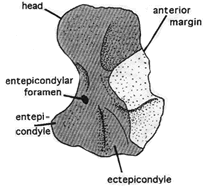 [2]
Clack (2001) makes the interesting point that the posterior stem on the
interclavicle is a developmental artifact. It gradually grows out into a
full diamond-shape during ontogeny. [3] in Clack (2001) the entepicondyle
is described as "triangular." From the figure in the later paper (at
right), the "quarter-circle" may refer to the ectepicondyle.
[2]
Clack (2001) makes the interesting point that the posterior stem on the
interclavicle is a developmental artifact. It gradually grows out into a
full diamond-shape during ontogeny. [3] in Clack (2001) the entepicondyle
is described as "triangular." From the figure in the later paper (at
right), the "quarter-circle" may refer to the ectepicondyle.
Comment: may be related to Temnospondyli
Links: AE TREE2000.pdf; relics: The creature from the black lagoon.
References: Clack (1998) [C98], Clack (2001) [C01]. ATW020820.
Images: Creature from the Black Lagoon (movie version) from The Uninhibited Uniform. Eucritta melanolimnetes life reconstruction by Dmitry Bogdanov MAK111112
| Page Back | Unit Home | Page Top | Page Next |
checked ATW060327, revised MAK111110